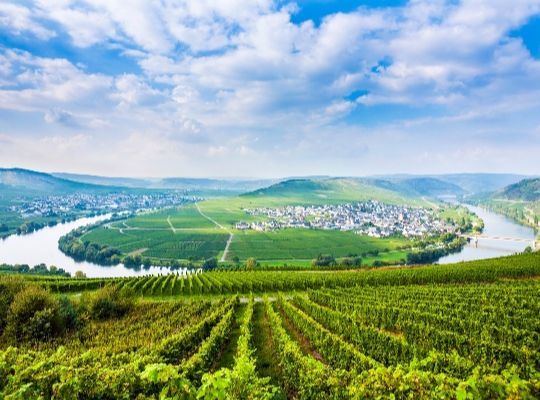
Germany, a country renowned for its precision engineering and rich cultural heritage, has quietly been crafting wines that are a testament to the country's commitment to quality. Over the years, German wines have faced challenges in gaining popularity and overcoming the stigma attached to them, especially stemming from the notorious Blue Nun era in the 1980s. However, recent advancements in the German wine industry, coupled with a renewed focus on quality, have ushered in a new era of appreciation for these wines. Ask any person in the wine trade their favourite grape, and more often than not they will reply with Riesling!
The 80s was a challenging period for German wines, with the emergence of Blue Nun as a symbol of mediocrity. Blue Nun, a Liebfraumilch wine produced in massive quantities, was often perceived as overly sweet and lacking in complexity. Its success contributed to a generalization of German wines as low-quality, sweet, and unsophisticated. This reputation, however unfair to the diverse and complex landscape of German winemaking, has lingered for years, with many wine lovers writing it off as poorly-made, sweet plonk.
In recent years, the German wine industry has undergone a remarkable transformation, focusing on quality over quantity. Winemakers have embraced sustainable and organic practices, enhancing the terroir-driven characteristics of their wines. Technological advancements, such as precision viticulture and modern winemaking techniques, have played a crucial role in elevating the overall quality of German wines. There is a younger generation of winemakers is experimenting with innovative styles and breaking away from traditional norms, injecting new energy and creativity into the industry.
Key grapes to look out for…
Undoubtedly the star of German wines, Riesling is celebrated for its versatility and ability to express the terroir in which it's grown. Ranging from bone-dry to lusciously sweet, Riesling wines captivate with their vibrant freshness, floral aromas, and flavours of citrus and stone fruits.
Germany's Pinot Noir, known locally as Spätburgunder, has gained international acclaim for its elegance and finesse. With a Burgundian influence, German Pinot Noirs often exhibit red fruit flavors, silky tannins, and a distinct mineral character.
Grauburgunder, otherwise known as Pinot Gris, is a style often grown over the border in Alsace in France. The grape has a slight pink tinge to the skin and can often be slightly tinted in colour and offers a lovely weight and richness to balance it’s fruity freshness.
In recent years, Germany has undergone significant reforms in its wine laws, which were previously based on sugar levels, the sweetest wine being the most highly-regarded. In response to consumer demand, they have now introduced the "Dry Qualitätswein" designation. This labelling term ensures that consumers can easily identify wines with minimal residual sugar, addressing the demand for the sleek, crisp profile that dry Rieslings exemplify.
A driving force behind the renaissance of German wines is the Verband Deutscher Prädikatsweingüter (VDP), an association of top-quality wine estates committed to the highest standards of viticulture and winemaking. The VDP has played a pivotal role in reshaping the image of German wines globally. They have introduced their own classification system that emphasizes terroir and quality very similar to that of Burgundy. They categorize vineyards into four tiers from lowest to highest: Gutswein, Ortswein, Erste Lage (Premier Cru), and Grosse Lage (Grand Cru).
The VDP members are commited to sustainable and organic viticulture which is helping to redefine the perception of German wines. Look out for the very Germanic symbol of an eagle holding 6 grapes to identify a VDP wine!
While Germany has long been celebrated for its still wines, there's a sparkling secret bubbling up from its vineyards – Sekt. The Germans are the biggest consumers of sparkling wine in the world and yet their fizz has long been overshadowed by the fame of Champagne and ubiquity of Prosecco.
Sekt is crafted from a variety of grapes, showcasing the diversity of Germany's wine regions. Producers tend to use traditional varieties like Riesling and Pinot Noir in the blend, mostly made using the tank method like Prosecco, to emphasise the fruity characteristics of the base wine.
Next time you see a bottle of German wine on the shelf, give it a try! It could surprise you…
4 modern German wines to try…
Dr. Loosen Extra Dry Sekt NV, £18.99 from Waitrose
A delightful sparkling wine made from 100% Riesling. Confusingly the “extra dry” in the name actually means it has a slight bit of sweetness, which balances the fresh and fruity flavours. An excellent aperitif.
Tesco Finest Steep Slopes Mosel Riesling, £7.25 from Tesco
An absolute bargain. As the name suggests, the grapes are sourced from the steep slopes of the Mosel Valley. Zesty lime and stone fruit characteristics and most importantly DRY!
Weingut Freidrich Becker Kalkmergel Grauburgunder, Pfalz, £16.00 mix six from Majestic
A dry Pinot Gris from a master producer of the variety. The slightly warmer climate of Pfalz allows for excellent ripening of this rich and juicy white wine. Very food-friendly.
Taste The Difference Rheinhessen Pinot Noir, £8.75 from Sainsburys
Another great value wine perfect for Spring. Light and fruity with fresh raspberry and strawberry notes. Chill it down and drink on its own or enjoy with some roast duck or pâté.

--600px.jpg)

--600px.jpg)
